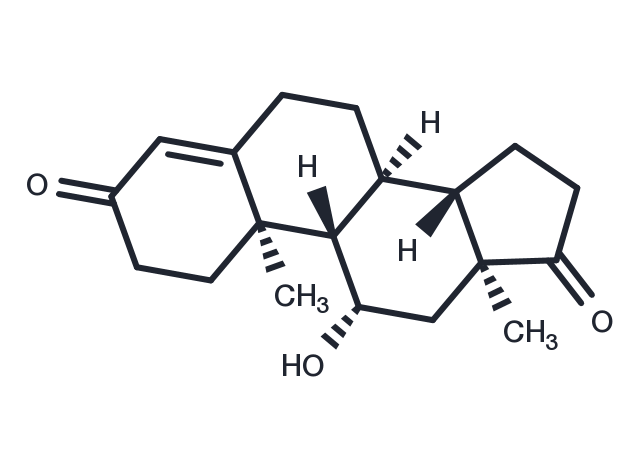Powder: -20°C for 3 years | In solvent: -80°C for 1 year


11-Beta-hydroxyandrostenedione (NSC-17102) is a steroid mainly found in the adrenal origin (11β-hydroxylase is present in adrenal tissue, but absent in ovarian tissue), which is a 11β-hydroxysteroid dehydrogenase isozymes inhibitor. Measuring plasma 11-Beta-hydroxyandrostenedione can distinguish the adrenal or ovarian origin of hyperandrogenism with 4-androstenedione increases.

| Pack Size | Availability | Price/USD | Quantity |
|---|---|---|---|
| 5 mg | In stock | $ 39.00 | |
| 10 mg | In stock | $ 64.00 | |
| 25 mg | In stock | $ 128.00 | |
| 50 mg | In stock | $ 208.00 | |
| 100 mg | In stock | $ 313.00 | |
| 500 mg | In stock | $ 753.00 | |
| 1 mL * 10 mM (in DMSO) | In stock | $ 43.00 |



| Description | 11-Beta-hydroxyandrostenedione (NSC-17102) is a steroid mainly found in the adrenal origin (11β-hydroxylase is present in adrenal tissue, but absent in ovarian tissue), which is a 11β-hydroxysteroid dehydrogenase isozymes inhibitor. Measuring plasma 11-Beta-hydroxyandrostenedione can distinguish the adrenal or ovarian origin of hyperandrogenism with 4-androstenedione increases. |
| In vitro | 21-deoxycortisol (21dF) and 21-deoxycortisone (21dE) are assayed within the LNCaP cell line to establish that this conversion is catalyzed by the lyase activity of CYP17A1. After the transfection of CYP17A1, 11-Beta-hydroxyandrostenedione (11OHA4)-pathway metabolites increase, 21dF, and 21dE are in fact metabolized to 11-Beta-hydroxyandrostenedione and 11-ketoprogesterone (11KP4) by CYP17A1, respectively [2]. |
| In vivo | In 21-hydroxylase deficiency, Cushing's syndrome, and hyperandrogenism of adrenal origin, the plasma concentration of 11-Beta-hydroxyandrostenedione (11beta-hydroxy-4-androstene-3,17-dione) is very high. In congenital 11-hydroxylase deficiency and adrenal insufficiency, the plasma concentration of 11-Beta-hydroxyandrostenedione (11beta-hydroxy-4-androstene-3,17-dione) is very low. Thus, when plasma 4-androstenedione is elevated, it is useful to measure the plasma 11-Beta-hydroxyandrostenedione level in order to determine the adrenal or ovarian origin of the hyperandrogenism [1]. |
| Synonyms | NSC-17102, 4-Androsten-11β-ol-3,17-dione |
| Molecular Weight | 302.41 |
| Formula | C19H26O3 |
| CAS No. | 382-44-5 |
Powder: -20°C for 3 years | In solvent: -80°C for 1 year
DMSO: 250 mg/mL (826.69 mM), Sonication is recommended.
You can also refer to dose conversion for different animals. More
bottom
Please see Inhibitor Handling Instructions for more frequently ask questions. Topics include: how to prepare stock solutions, how to store products, and cautions on cell-based assays & animal experiments, etc.
11-Beta-hydroxyandrostenedione 382-44-5 Metabolism Endogenous Metabolite 11Betahydroxyandrostenedione inhibit 4-androstenedione Cushing's hyperandrogenism adrenal syndrome NSC-17102 Inhibitor NSC17102 4-Androsten-11b-ol-3,17-dione 4-Androsten-11β-ol-3,17-dione 4-Androsten-11beta-ol-3,17-dione NSC 17102 steroid 11-β-hydroxyandrostenedione 11 Beta hydroxyandrostenedione 11-b-hydroxyandrostenedione 11β-hydroxylase ovarian inhibitor
